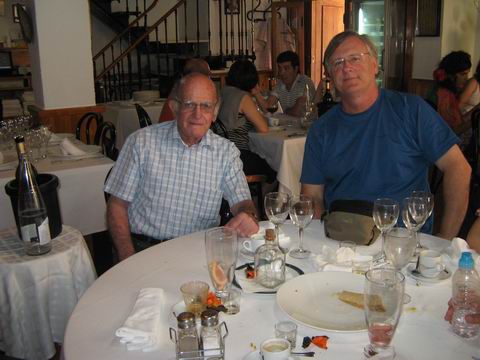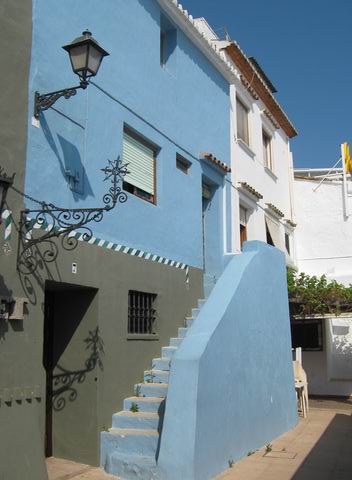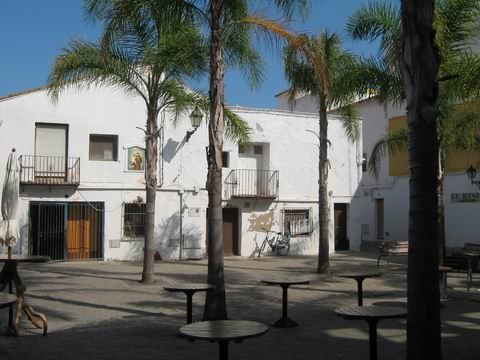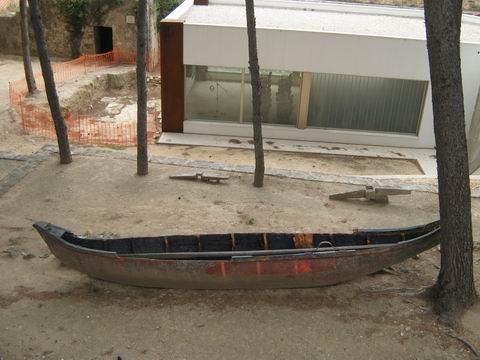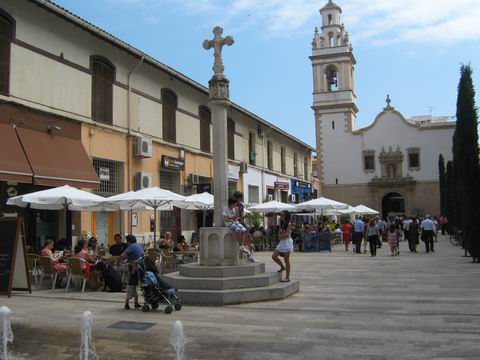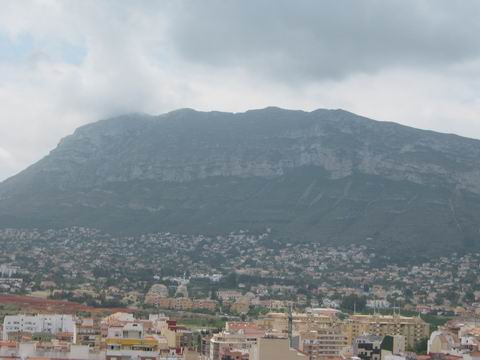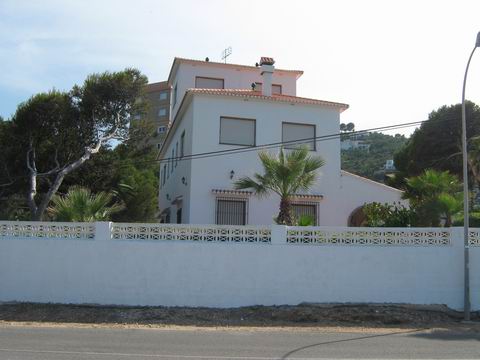Denia has changed since Hollywood arrived here in 1958 to make Samuel Bronson’s first super-production: John Paul Jones (1959)
The film was shot in 1958 and caused a revolution in this sleepy fishing village, bringing American dollars, Coca Cola and Mia Farrow (daughter of director John Farrow) to a needy population still suffering the post-war syndrome under the Franco Dictatorship.
The choice of Denia was largely due to the influence of John Cabrera, whose family had left the village for Liverpool years before, and was chosen after flying along the coast in a light aircraft looking for places that could represent the coasts of Scotland, the USA and even the Caribbean!
Our walk however begins not in the air but on the beach, at the Playa del Raset, just to the north of the port.
It was here that the beach scenes of the siege of La Rochelle were shot in the filming of Richard Lester’s The Four Musketeers (1974) starring Michael York, Oliver Reed, Faye Dunaway, Christopher Lee, Rachel Welch and Frank Finlay among others.
The British soldiers in these scenes were in fact mostly Spanish soldiers from a regiment based in nearby Alcoy.
As we walk back towards the port, we can see a row of bars and restaurants to our right in Plaza El Raset. Unfortunately the new terraces have covered up the old fishing village houses. Nevertheless, we can still see a blue painted house with a staircase going up the façade.
John Paul Jones (1959) director John Farrow liked the staircase so much that he had a copy made and fixed to the façade of a house in the Plaza Sant Antoni, which is behind Plaza del Rasset and a little further towards the town centre.
Mia Farrow’s brother John Charles Farrow had a brief part in the film as John Paul Jones the young Scottish boy who throws an egg at a British officer. This scene supposedly takes place at a small square in the Scottish village where Jones was born.
When John Charles returned to Denia for the 50th anniversary of the making of the film in 2008, he was moved to see the original staircase still there.
Plaça Sant Antoni is still recognisable, although it has grown a few bars since the film was made.
52 years later, the same square was once again used by Hollywood for a film shot up and down the Costa Blanca starring Bruce Willis; The Cold Light of Day (2011)
Winding through some atmospheric streets of the old fishing port, we can find in Carreró del Malcriat a statue that commemorates the making of John Paul Jones (1959)
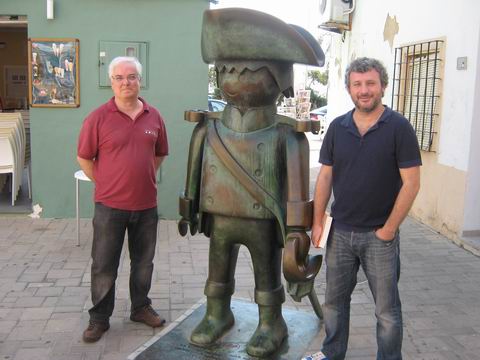
From Plaça Sant Antoni, and in fact from most places in Denia, we can see the castle, which in one form or another has been occupied by Romans (who named the city after the Goddess Diana), Moors and Christians. It was also occupied by the British during the 18th century War of Spanish Succession and by Napoleon’s troops during the 19th century.
In John Paul Jones (1959)however, the castle represented Whitehavenbeing stormed by Jones’s raiding party.
The point where we see them climbing upwards with the castle wall to their right is the Punta del Diamant.
At another part of the castle, next to the new audio-visual centre by the Torre de les Pusses, we can still see one of the boats used in the film Java: East of Krakatoa (1969).
The centre of Denia has many landmarks that were part of the ‘invasion’ of Denia that constituted the making of John Paul Jones (1959).
Coming down from the castle, and entering the Plaza de la Constitución, we find the church (Asunción) where Mia Farrow used to hand out food to the hungry poor of Denia as part of her duties as Queen of the Festival of 1958.
In the Glorieta del Pais Valencia is a restaurant called La Casa de l’arròs, which in 1958 provided accommodation for some of the crew working on the film.
In Calle Marques de Campo at number 17, we find what used to be the Hotel Comercio, where members of the production team stayed,
and at the end of the same street is the ruin of what used to be the Bar Mediterranea, one of the logistics centres of the film.
In the Plaça del Convent, where the church of San Antonio stands, one side of the square is made up of the English warehouse (El Almacén de los Ingleses), a name that refers to its use by English merchants for storing Denia’s main export; raisins.
The building, which is now a Mercadona supermarket, was used as the HQ for the film, for costume storage, as well as for the shooting of some ship interior scenes for the film Java: East of Krakatoa (1969).
It is the port that has been the main attraction that Denia offered film-makers during the 50s, 60s and 70s, before modern buildings sprang up (ironically partly due to the new-found prosperity brought about by the influx of foreign film companies looking for authentic, old-fashioned locations).
In the section of the port located at the end of Passeig del Saladar, ships came and went for films such as Cervantes (1967), which was an attempt to tell the story of Cervantes’ youth with locations all over Spain including Denia for the port scenes representing Algiers, which is curious bearing in mind that when Cervantes returned from captivity to Spain, he actually landed in Denia.
The Four Musketeers (1974),where we see the brief port scenes, including the assassination of the Duke of Buckingham (Simon Ward) and Milady’s return to France after plotting his demise. In The Three Musketeers (1973) the port scenes were shot during August and September 1973 in Denia.
The Dover port scenes were shot at the dockside, whereas the port of Calais was represented at nearby (certainly nearer than Calais) El Raset, with the black façade of the ‘Cofradía de Pescadores’ (Fishermen’s Building) in the background.
In Java: East of Krakatoa (1969). Denia became Singapore, with a bit of paint here, an Oriental face there with a lot of sea and men throwing buckets of water and rubber rocks at the actors.
Denia is used for the opening dock scenes, although most of the rest, including Krakatoa is plastic models, although it was sometimes substituted, when it got tired no doubt, by the emblematic local mountain Montgó. Occasionally, when the camera swings the wrong way you can see white villas on the shore where hundreds of Northern European pensioners have made their homes and their own little Germanys and little Belgiums.
Although made largely in Shepperton Studios, London, HMS Defiant (1962) also used the boats in Denia’s harbour. In some scenes the distinctive MontgoMountain between Javea and Denia can be identified, posing as the coastline of Sicily.
Denia was also the English port from which Defiant set sail, and where we see Guinness and his son saying farewell.
Billy Budd (1962), starring and directed by Peter Ustinov, the film used Alicante port as a base, which was highly popular for period pieces at the time. The ships used in the making of John Paul Jones were also employed in this film.
Terence Stamp makes his debut as a pressed sailor, in the non-grape or olive sense of the word, and Robert ‘Flogger’ Ryan adds an enviable element of unbalanced character acting. The story, set in 1797, the year the British Navy mutinied (but don’t tell anyone!) was written by Herman ‘Moby’ Melville.
Filmed mostly at sea, which could have been anywhere and probably was, it’s grey seas and grey ethical areas for most of the film.
In HMS Defiant (1962) Guinness plays good cop to Dirk Bogarde’s bad cop in a naval adventure with the Spithead Mutiny as its setting. English sailors prove once again that with just a minor reduction in flogging they are prepared to give their all for a decent chance of killing Frenchmen.
The sea scenes were all filmed around Denia, even though the action supposedly took place at Spithead, Corsica and Italy.
If we head south along the promenade, we eventually come to the Marineta Cassiana beach, and it was here during the shooting of Honeymoon Academy (1990) that a car chase that began in the pine forests around Javea, finished. A ramp was especially built so that the bus involved in the chase could soar into the air and land on the beach.
Continuing along the beach through the area known as Las Rotas, past the well hidden EnglishCemetery, we can see a tower upon the hill known as Torre del Gerro.
Dirk Bogarde and Alec Guinness rented a house named after and situated below the Torre (Tower), and Bogarde apparently caused a stir on the local streets, riding around in his Rolls during the making of HMS Defiant (1962).
In The Three Musketeers (1973) when Michael York calls out that he has at last spotted Dover, he is in fact in front of Cap (Cape) de Sant Antoni, which can be seen a bit further south from here.
Our thanks to Toni Reig, Miquel Crespo, Romu Soler and John Cabrera for their invaluable help in producing this guide.
All information from www.moviesmadeinspain.com

